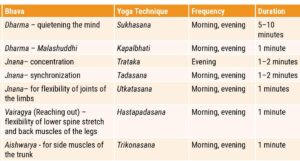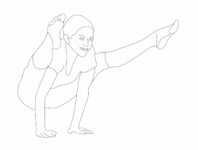Children are the future of humanity. If they live a happy and healthy life, they will strive for higher pursuits and achieve the highest goal of life. A child’s physical body has all organs and organ systems that are growing and are under development. Poor posture can spoil the spine’s shape lack of nutrition and exercise can result in poorly developed limbs and the musculoskeletal system. Yoga can help children grow and develop to their optimum best and live healthy, happy, and fulfilling childhood. The key lies in orienting them correctly.

Yoga benefits for children
The pace and rhythm of the modern world have now trickled down into childhood life. Children today are under a lot of stress: homework, pressure to compete with other children, endless after-school activities, over-scheduling – it all adds up. As the lifestyle of children has started to resemble that of adults, Yoga is a way to help adults and children relax and rediscover themselves
- Yoga can develop the children’s gross and fine muscles, making them strong and supple.
- Yoga keeps all glands well-balanced for all-round physical growth. Yoga trains the sense organs for better functioning.
- Yoga sharpens the child’s learning.
- Yoga helps children to develop better awareness, self-control, flexibility, and coordination at physical and mental levels.
- It also assists them in understanding how they can carry these skills beyond the classroom and into their daily routines.
Yoga for the age group of 5 to 6 years children

Yoga for the age group of 7 to 9 years children

Yoga for the age group of 10 to 12 years children

Yoga limitations for children
- Children less than 6 years of age stay up to 10 seconds in the final stage of any Asana /Yoga practice.
- The total time for the kid’s Yoga session should be not more than 35 minutes.
- Children are advised not to perform Asana for long duration and breath-holding practices (Kumbhaka).
- Avoid extreme Forward and Backward bending Asanas.
- Avoid headstands and hand-standing Asanas.
- Avoid over-stretching or being pushed too hard while practising Yoga.
- Yogic practice should be done on an empty or light stomach.
- Children should practice Yoga under the supervision of an expert/trained Yoga teacher with proper guidance and never alone.
- If a child complains of any discomfort while or after practising Yoga, she/he should be given full attention and medical help, if needed.
- It is always appreciated to teach Yoga with affection and deal with all their reactions tenderly.
- Yoga is not merely a set of physical exercises; they are psycho-spiritual practice, where the body is the means. Therefore, basic principles of Yoga like Yama and Niyama shall be emphasised while teaching Yoga practices to get better results.
13 Yoga Poses for Children
- Yogic Sukshma Vyayama: (Micro Circulation Practices) such as Neck Movement – Up and down and Left and right; Hands Up and down, Hands Rotation, Shoulder rotation, Shaking Wrist, Back Movement- Forward & backwards, Twisting, Side Bending, Butterfly Movement, Knee Movement, Ankles – Gulf Naman (In & out bending) and Gulf Chakr (Rotation)
- Tadasana (Palm tree posture)
- Vrikshasana (Tree posture)
- Trikonasana (Triangle posture)
- Ushtrasana (Camel posture)
- Shashakasana (Rabbit posture)
- Gomukhasana (Cow posture)
- Simhasana (Roaring lion posture)
- Bhujangasana (Cobra Pose)
- Dhanurasana (Bow posture)
- Balasana (Child posture)
- Setubandhasana (Bridge posture)
- Deep Breathing and Bhramari Pranayama






